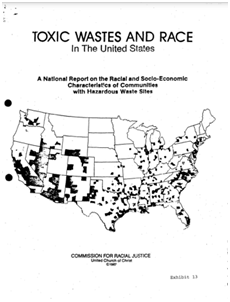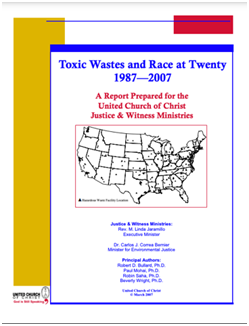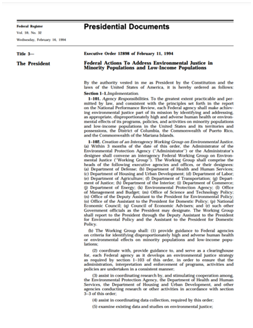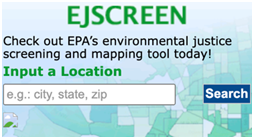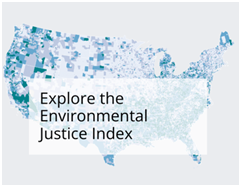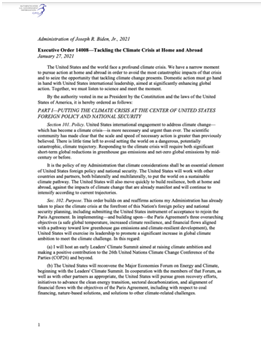EJ Materials
Content TBD
This groundbreaking report has been cited by many as the first comprehensive finding of systemic environmental racism in the United States. The report was showed that race there were definitive patterns showing that communities with higher percentages of diverse and non-White populations were more likely to be chosen as sites for toxic waste facilities (e.g., hazardous waste disposal sites, etc.) with a disproportionate number of uncontrolled toxic waste sites sited in urban areas near Black and Hispanic neighborhoods. The report found that race was the “most significant among variables tested in association with the location of commercial hazardous waste facilities” and that this was a national patter. The report suggests that this finding could not have happened by accident and rather the locations of these sites were found based on underlying factors related to systemic racism.
This report from the United Church of Christ is a follow-up to the original “Toxic Wastes & Race in the United States” report issued in 1987. Authored by distinguished professors Robert Bullard, Paul Mohai, Robin Saha and Beverly Wright, this report notes “the conclusions of the 1987 Report are similar to those of [this] updated report. In fact, in Toxic Wastes and Race at Twenty report you will read that ‘people of color are found to be more concentrated around hazardous waste facilities than previously shown.’ You will see that race matters. Place matters too. Unequal protection places communities of color at special risk. And polluting industries still follow the path of least resistance, among other findings.”
After a decade of community activism and pressure for the U.S. federal government to take a stand against environmental injustice, President William J. Clinton issued Executive Order (E.O.) 12898 on February 11, 1994. The purpose of E.O. 12898 was to focus federal attention on the environmental and human health effects of federal actions on EJ communities. The E.O. directs government agencies to consider the EJ impacts of many federal actions. It also established an Interagency Working Group (IWG) on environmental justice chaired by the EPA Administrator.
EJScreen is the United States Environmental Protection Agency’s (EPA) environmental justice GIS mapping and screening tool. This comprehensive mapping tool provides EPA and users with a nationally consistent dataset and approach for combining environmental and socioeconomic indicators that underlie EJ issues. All of the EJScreen indicators are derived from publicly availabledata. EJScreencombines environmental and demographic indicators into “EJ Indexes” and consists of diverse data, including 12 environmental indicators, 7 socioeconomic indicators, 12 “EJ indexes” and 12 supplemental indexes. The EPA produced a short video to explain the basics of EJScreen.
The Environmental Justice Index (EJI), created by the United States Agency for Toxic Substances and Disease Registry (ATSDR), is the first national, place-based tool designed to measure the cumulative impacts of environmental burden. The EJ Index provides a score for each community so that stakeholders and public health officialscan identify and map areas most at risk for the health impacts of environmental contamination. This mapping tool is intended to help public health officials prioritize action for those communities most at need. However, anyone in the sustainability and environmental, social and corporate governance (ESG) space should familiarize themselves with the EJ Index. The EJ Index uses data from various federal datasets to rank the cumulative impacts of environmental injustice on health for every census tract. The EJ Index then ranks communities on 36 environmental, social, and health factors.
On his first day in office, President Biden signed several Executive Orders that included specific federal initiatives focused on environmental justice and advancing equity to disadvantaged communities. President Biden issued Executive Order 13985 – on Advancing Racial Equity and Support for Underserved Communities through the Federal Government – ordered executive departments and agencies to work towards redressing inequities in their policies and programs that have historically served as barriers to equal opportunity. The President also issued Executive Order 13990 – on Protecting Public Health and the Environment and Restoring Science To Tackle the Climate Crisis – announcing that his Administration would advance environmental justice on a federal level. However, President Biden’s most ambitious and comprehensive federal action on environmental justicecame when he issued Executive Order (E.O.) 14008 on Tackling the Climate Crisis at Home and Abroadon January 27, 2021. Executive Order 14008 builds on the foundational efforts of President Clinton’s Executive Order 12898 on Federal Actions to Address Environmental Justice in Minority Populations and Low-Income Populations, which recognizes that while Americans deserve to live in healthy, thriving communities, too many people from disadvantaged communities lack access to safe places to live, work, play and worship. E.O. 14008 established several brand-new federal environmental justice initiatives, including creating the White House Environmental Justice Interagency Council (IAC) and the first-ever White House Environmental Justice Advisory Council (WHEJAC). The E.O. also established the “Justice40 Initiative,” a federal government policy which aims to provide 40 percent of the overall benefits of Federal investments relating to climate change and clean energy to disadvantaged communities.

